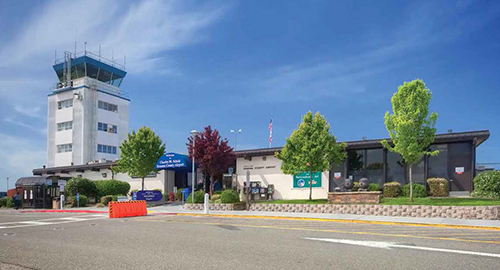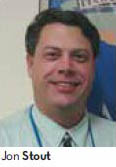High-Tech Strategies for Lease Management
 Managing airport leases inherently requires a lot of recordkeeping. Even for a basic T-hangar, airports must document specific dimensions, features and improvements. Necessary tenant information includes the type of plane, amount of rent, payment dates and current proof-of-insurance. Multiply all that by 200 or 300 hangars, and the task becomes daunting for smaller airports with limited staff and budgets.
Managing airport leases inherently requires a lot of recordkeeping. Even for a basic T-hangar, airports must document specific dimensions, features and improvements. Necessary tenant information includes the type of plane, amount of rent, payment dates and current proof-of-insurance. Multiply all that by 200 or 300 hangars, and the task becomes daunting for smaller airports with limited staff and budgets.
Factor in other categories of leases, such as restaurants, parking, car rental and storage facilities - each with their own specific recordkeeping requirements - and the time required further multiplies.
Early this year, Charles M. Schulz-Sonoma County Airport (STS) began using cloud-based software - ProLMS from ProDIGIQ - to ease its recordkeeping burdens. With nearly 400 tenants to track, lease management had become an increasing challenge for the California wine country airport.
 factsfigures factsfiguresProject: Lease Management Location: Santa Maria (CA) Public Airport Annual Operations: 45,450 Lease Volume: 280 Full-time Employees: 12 Location: Truckee Tahoe (CA) Airport Annual Operations: 26,500 Lease Volume: 250 Full-Time Employees: 19 Location: Charles M. Schulz-Sonoma County (CA) Airport Annual Operations: 80,000 Lease Volume: 390 Full-Time Employees: 13 Software Product: ProLMS Vendor: ProDIGIQ Key Benefits: Streamlines process for recordkeeping about airport tenants; improves access to financial data for staff & board members; helps track tenant & airport hangar improvements |
"When I started in 2002, we used spreadsheets and paper files," recalls Airport Manager Jon Stout. "(Then) we started with a software program called Property Boss. It was OK for hangars themselves, but not for fuel flow, landing fees, percentage rents and other categories." When the airport expanded some of its leases over time, charging different rents for different buildings, the process eventually started to fail.
Providing timely information to Sonoma County's budget analyst and auditor had also become problematic. "When they asked for information, we had to go back to our files to get it," Stout recalls. "This often took a day or two, and was very time-consuming. That is when we started to look at other solutions."
Stout and his staff talked to several vendors, but none offered the services they needed. And using software from other county departments didn't work, either. "Sonoma County has a marina at the tip of San Francisco Bay; they lease (space) like we do, for things like boat slips, stores and restaurants. But it just did not translate to our situation," Stout explains.
One problem was keeping track of who owned each aircraft. "There might be one person who signed the lease, but he had four partners. Getting all the information together took a lot of time," he elaborates.
Most of STS' leases (about 300) are for private hangars, but Alaska Airlines also flies Bombardier Q400s into the airport from several West Coast cities. Besides renting hangars, the airport maintains leases for a restaurant, car rental, parking, air ambulance service and tenants of an on-site industrial park. In addition, it collects income from special events such as movie shoots, and police departments rent some of its old taxiways for driver training.
After four months operating with the new software, Stout is happy how the new system handles the airport's various leases. "We know already that this program saves staff resources and improves communication between us and the county budget officials," he reports. "And the people on our staff who use it every day say it has made their jobs easier."
airport's various leases. "We know already that this program saves staff resources and improves communication between us and the county budget officials," he reports. "And the people on our staff who use it every day say it has made their jobs easier."
Having comprehensive document storage was a major selling point, he notes. Auditors can now open up any file using the system's read-only feature.
Convincing the county's Purchasing Department to buy the program was a bit challenging, Stout acknowledges. Because there are no similar software services in the industry, the purchase didn't follow the country's usual competitive bid process. "They were uneasy about that, but we convinced them to give us the green light," Stout relates.
The airport started migrating its lease data last September, and went completely online in January 2014. "The engineers at ProDIGIQ took our old Excel spreadsheets and imported much of the data to the new program," Stout reports. "T-hangar rentals were easy, but some of the other businesses were more difficult to move over. We did the rest of the inputting ourselves."
The inputting process itself proved beneficial. "It showed the airport staff that we were missing a lot of data that was paper-based, such as insurance and aircraft registration," he relates. This realization, in turn, prompted tweaks to the airport's new program to prevent future documentation lapses.
data that was paper-based, such as insurance and aircraft registration," he relates. This realization, in turn, prompted tweaks to the airport's new program to prevent future documentation lapses.
Stout also had ProDIGIQ add a graphic map interface that uses an overview photo of the airport. "Now, airport staff or someone from the auditor's office can click on the image of a hangar and get information on its dimensions and price," he explains.
The company added a similar feature for main terminal leases such as car rental companies, vending machines, kiosks, restaurants and stores. "We now have a drop-down menu, so when one of our staff members or an authorized county auditor wants information on a specific tenant, they can simply click on the graphic of the category and get the information," says Stout.
The customized features of the STS system illustrate ProDIGIQ's product and service strategies. "Our goal is to offer all-inclusive solutions based on what each client wants," explains Arpit Malaviya, the company's vice president of business development. "The fact that ProLMS adapts to each airport's unique business processes, rather than the airport adapting to the system, has led to this product's fast growth in the industry. We also work very hard to provide excellent customer service."
Switching Systems
Further down the coast, Santa Maria Public Airport (SMX) has been using ProLMS to manage its diverse assortment of tenants for almost two years. The small, Santa Barbara-area facility monitors about 280 leases. That requires detailed recordkeeping for 175 general aviation hangars, 25 commercial aviation leases, 20 storage facilities, eight airlines (including cargo companies such as FedEx), five agricultural leases (predominantly strawberry growers), four rental car companies, business park tenants and other miscellaneous categories.
Before migrating to ProDIGIQ's cloud-based system, SMX personnel used Microsoft Access to track leases and backed up the electronic files with paper copies, says General Manager Chris Hastert. "The problem we had with Access is that it was hard to change things," Hastert explains.
"We have only 12 full-time employees, including maintenance workers. We had only one person
skilled in Access; so if that person was out, we could not check on a lease."
The airport also found that mistakes were sometimes irreversible under its previous system. This prompted the frustrating need to restore the database from a previous backup and reenter information that was added after the backup.

Staff also found it difficult to find specific financial information for SMX's five-member elected board. Answering a question from board members sometimes took several days. "This really became an issue for us, and that is why we started to shop around for some new software," Hastert recalls.
Over several meetings with Malaviya from ProDIGIQ, Hastert described the specific capabilities his airport needed. "For example, I told him I wanted to have e-mail reminders when leases were due to expire, and they were able to implement that into the program," he notes.
After ProDIGIQ installed the system at the airport, an SMX employee entered lease data from printouts of the old Access files. With details for nearly 300 leases to enter, the process took two to three weeks. "Fortunately, she was very detail-oriented; and I oversaw what she did," Hastert says.
With the system up and running, he appreciates that anyone on staff can use ProLMS and board members can access, but not change, lease files.
Hastert has also found that the airport's customized software:
- makes it easy to reach tenants quickly - to report storm damage to hangars, for instance
- provides a quick look at airline data with details about passenger counts and flight volume
- helps verify that tenant and airport improvements are made on schedule
- facilitates payment and reimbursements for farm tenants' water bills
Paper vs. Program
Truckee Tahoe Airport (TRK), a central California facility that handles about 26,500 operations per year, derives most of its operating income from 230 rental hangars. It's consequently crucial for Jane Dykstra, the airport's director of finance and administration, to access information about leases.
With just 19 full-time staffers, keeping up with the recordkeeping necessary for each tenant had become a real challenge. "There just seemed to always be some piece of information missing in each file, such as the dimensions of each hangar, maintenance records, the tenant's deposit or insurance information," Dykstra recalls.
A three-month trial of ProDIGIQ's cloud service turned into a six-month demo and eventually a software purchase and three-year service subscription (long enough to earn the airport a discount). Most of the airport's training was performed virtually, notes Dykstra. "They were very good at addressing our questions," she adds.
After using the system for about six months, Dykstra was confident it had made the airport more efficient in many ways. "It is much easier for us to track tenants in each hangar," she explains. "ProLMS allows us to input the N number for each plane, the type of aircraft, certification of insurance and proof that the owner did an annual safety inspection."
Additionally, the program records key data for each hangar, including its overall dimensions, door width, floor type (asphalt or concrete) and height. It also notes which way each hangar's door faces. Due to the slope of hangar roofs and the airport's mountainous locale, east-facing hangars have issues with snow melting and running off the roof, while west-facing hangars tend to have snow melt more slowly on the pavement in front of the hangar. Having detailed information about each hangar facilitates long-term maintenance and helps the airport keep tenants informed.
The software also helps TRK manage an issue that previously caused a lot of hassles. "Our airport has land in two separate counties, Nevada and Placer; and each has its own tax assessor," explains Dykstra. "Plane owners receive tax bills based on the county in which their hangar is located."
The airport, however, is responsible for reporting to both counties about which aircraft are based in which county. "It was extremely time-consuming doing all of these tax records when you had to pull the paper files for all the tenants and report the data," Dykstra recalls.
Streamlining the previously cumbersome process is just one way the airport's purchase has already proved its value.
FREE Whitepaper
PAVIX: Proven Winner for All Airport Concrete Infrastructure
International Chem-Crete Corporation (ICC) manufactures and sells PAVIX, a unique line of crystalline waterproofing products that penetrate into the surface of cured concrete to fill and seal pores and capillary voids, creating a long lasting protective zone within the concrete substrate.
Once concrete is treated, water is prevented from penetrating through this protective zone and causing associated damage, such as freeze-thaw cracking, reinforcing steel corrosion, chloride ion penetration, and ASR related cracking.
This white paper discusses how the PAVIX CCC100 technology works and its applications.








